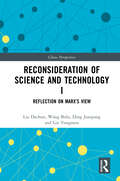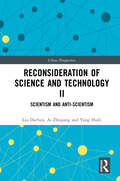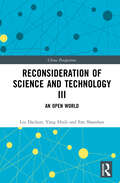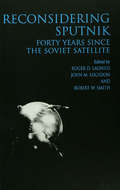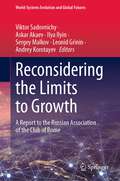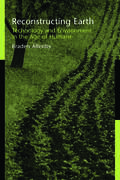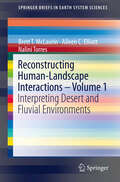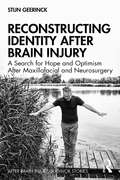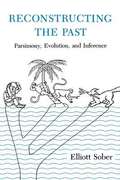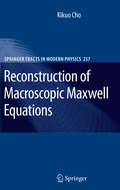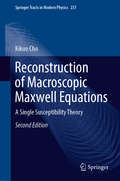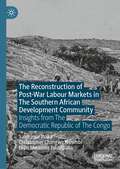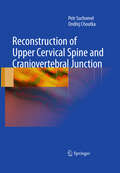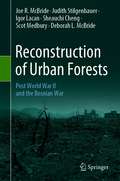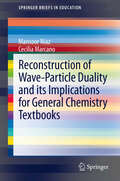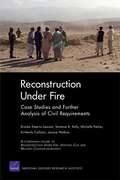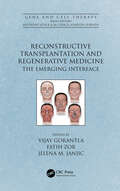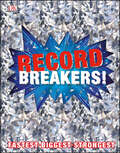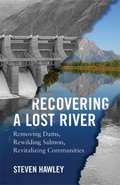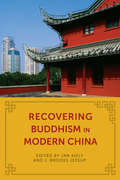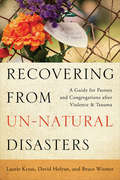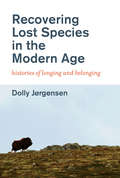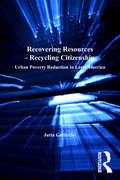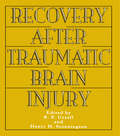- Table View
- List View
Reconsideration of Science and Technology I: Reflection on Marx’s View (China Perspectives)
by Liu Dachun Wang Bolu Ding Junqiang Liu YongmouThis volume analyzes Karl Marx’s understanding of science and technology and how it is associated with his focus on the perspective of history and human practice, seeking to illuminate a renewed understanding of science and technology from a Marxist angle. As the first volume of a three-volume set that proposes to reconsider science and technology and explores how the philosophy of science and technology responds to an ever-changing world, the book delves into Marx’s analysis of scientific and technological problems and phenomena across five chapters. The authors explain the positioning of science and technology and the Marxist theoretical perspective of history and practice from which Marx’s views on science and technology derive before an examination of three focal dimensions pertaining to science and technology: productivity, technological alienation and liberty. Not always viewed as central to Marx’s works, discussions on science and technology are often underdeveloped – but a reinterpretation of Marx’s thoughts on the issues corroborates the efficacy of Marxism in terms of understanding today’s world and especially the development of science and technology. The volume will appeal to scholars and students interested in Marxist philosophy, the philosophy of science and technology and topics related to scientific culture.
Reconsideration of Science and Technology II: Scientism and Anti-Scientism (China Perspectives)
by Liu Dachun Ai Zhiqiang Yang HuiliIn reviewing and reconsidering the intellectual history of scientism and antiscientism, the authors assess the process of reasoning and prejudices of these contrasting viewpoints, while discussing the repercussions of scientific hegemony and its contemporary criticism. As the second volume of a three-volume set that proposes to reconsider science and technology and explores how the philosophy of science and technology responds to an ever-changing world, this title focuses on ideological trends centering around scientism and anti-scientism since the 19th century. The six chapters look into the emergence of scientism, instrumental reason, scientific optimism, scientific pessimism, scientific crisis and irrationalism and finally the deconstruction of scientism. The authors provide insight into the connections and biases of these disparate views and critiques, explore the influences of the hegemony of science and contemporary critique of science and evaluate the value of postmodernism and deconstructivism. The volume will appeal to scholars and students interested in the philosophy of science and technology, the ideology of scientism and anti-scientism, modernism and postmodernism, Marxist philosophy and topics related to scientific culture.
Reconsideration of Science and Technology III: An Open World (China Perspectives)
by Liu Dachun Yang Huili Fan ShanshanDrawing on debates from traditional and postmodern thoughts on science and technology, the title builds a new theoretical framework to reconsider science and technology, integrating the opposing viewpoints that either justify science or negate it. As the third volume of a three-volume set that proposes to reconsider science and technology and explores how the philosophy of science and technology responds to an ever-changing world, this final volume seeks to restore the cultural implications of science. Across the six chapters, the authors probe the prospect of a pluralistic scientific culture, including discussions of diversified value choices, the tension between reason and unreason, other binary characteristics of scientific knowledge, including objectivity and uniqueness, universality and locality, as well as the loss, awakening and reconstruction of scientific culture. The authors call for a transformation of scientific culture from a dominant culture to an affirmative one and envision a free and open world of science and technology. The volume will appeal to scholars and students interested in the philosophy of science and technology, the ideology of scientism and anti-scientism, modernism and postmodernism, Marxist philosophy and topics related to scientific culture.
Reconsidering Sputnik: Forty Years Since the Soviet Satellite (Routledge Studies in the History of Science, Technology and Medicine #11)
by Robert W. Smith Roger D. Launius John M. LogsdonThis book explores Russia's stunning success of ushering in the space age by launching Sputnik and beating the United States into space. It also examines the formation of NASA, the race for human exploration of the moon, the reality of global satellite communications, and a new generation of scientific spacecraft that began exploring the universe. An introductory essay by Pulitzer Prize winner Walter A. McDougall sets the context for Sputnik and its significance at the end of the twentieth century.
Reconsidering the Limits to Growth: A Report to the Russian Association of the Club of Rome (World-Systems Evolution and Global Futures)
by Viktor Sadovnichy Askar Akaev Ilya Ilyin Sergey Malkov Leonid Grinin Andrey KorotayevEchoing the famous "The Limits to Growth" report from 1972, this edited volume analyses the changes that the World System has undergone to the present, on the fiftieth anniversary of the original report. During the past fifty years, both the concept and understanding of these limits have significantly changed. This book highlights that the evolution of the World System has approached a new critical milestone, moving into a fundamentally new phase of historical development, when the old economic and social technologies no longer work as efficiently as before or even begin to function counterproductively, which leads the World System into a systemic crisis. The book discusses the transition of human society to a new phase state, the shape of which has not yet been determined. New approaches are needed for both, for the analysis of the global situation, and for forecasts. The book is based on an integrated approach including the world-systems, historical and evolutionary perspectives, as well as a systematic view of society, in which changes in one subsystem cause transformations in others. Through mathematical modeling, it defines the main vectors of transformations of the World System; makes a detailed forecast of the development of all the main subsystems of the society and the World System, while presenting horizons of changes from short-term to ultra-long-term; and presents different development scenarios as well as recommendations on how to achieve a transition to the most favorable scenario. The book will appeal to members and followers of the Club of Rome, policy-makers, as well as to scholars from various disciplines interested in a better understanding of the World System evolution, global futures, development studies, climate change, and future societies.
Reconstructing Earth: Technology and Environment in the Age of Humans
by Braden AllenbyThe Earth's biological, chemical, and physical systems are increasingly shaped by the activities of one species-ours. In our decisions about everything from manufacturing technologies to restaurant menus, the health of the planet has become a product of human choice. Environmentalism, however, has largely failed to adapt to this new reality.Reconstructing Earth offers seven essays that explore ways of developing a new, more sophisticated approach to the environment that replaces the fantasy of recovering pristine landscapes with a more grounded viewpoint that can foster a better relationship between humans and the planet. Braden Allenby, a lawyer with degrees in both engineering and environmental studies, explains the importance of technological choice, and how that factor is far more significant in shaping our environment (in ways both desirable and not) than environmental controls. Drawing on his varied background and experience in both academia and the corporate world, he describes the emerging field of "earth systems engineering and management," which offers an integrated approach to understanding and managing complex human/natural systems that can serve as a basis for crafting better, more lasting solutions to widespread environmental problems.Reconstructing Earth not only critiques dysfunctional elements of current environmentalism but establishes a foundation for future environmental management and progress, one built on an understanding of technological evolution and the cultural systems that support modern technologies. Taken together, the essays offer an important means of developing an environmentalism that is robust and realistic enough to address the urgent realities of our planet.
Reconstructing Human-Landscape Interactions - Volume 1
by Aileen C. Elliott Nalini Torres Brett T. MclaurinThe Holocene is unique when compared to earlier geological time in that humans begin to alter and manipulate the natural environment to their own needs. Domestication of crops and animals and the resultant intensification of agriculture lead to profound changes in the impact humans have on the environment. Conversely, as human populations began to increase geologic and climatic factors begin to have a greater impact on civilizations. To understand and reconstruct the complex interplay between humans and the environment over the past ten thousand years requires examination of multiple differing but interconnected aspects of the environment and involves geomorphology, paleoecology, geoarchaeology and paleoclimatology. These Springer Briefs volumes examine the dynamic interplay between humans and the natural environment as reconstructed by the many and varied sub-fields of the Earth Sciences.
Reconstructing Identity After Brain Injury: A Search for Hope and Optimism After Maxillofacial and Neurosurgery (After Brain Injury: Survivor Stories)
by Stijn GeerinckReconstructing Identity After Brain Injury tells the remarkable story of Stijn Geerinck and his journey from road traffic accident to recovery. After he was hit by a drunk driver whilst cycling, Stijn suffered a traumatic brain injury and had to undergo drastic maxillofacial and neurosurgery. In his own words, this book narrates Stijn’s difficult recovery, focusing on the physical, medical, mental, social and financial changes he had to endure. It lays the groundwork for coping with permanent impairment resulting from TBI, including lifelong lesions and the irreversible physical changes. The testimonial narrative is complemented with philosophical insights, providing key philosopher’s reflections on the experience of brain injury. Stijn also explores the essential human characteristics of resilience, fighting spirit, emotionality, despair, vulnerability, hope, depression, optimism, anxiety, rationality, focus, anger and love, as he looks at the impact of his brain injury and resulting disfigurement on his masculine identity. It is essential reading for any professional involved in neuropsychological rehabilitation, and all those touched by this condition.
Reconstructing the Past: Parsimony, Evolution, and Inference
by Elliott SoberReconstructing the Past seeks to clarify and help resolve the vexing methodological issues that arise when biologists try to answer such questions as whether human beings are more closely related to chimps than they are to gorillas. It explores the case for considering the philosophical idea of simplicity/parsimony as a useful principle for evaluating taxonomic theories of evolutionary relationships.For the past two decades, evolutionists have been vigorously debating the appropriate methods that should be used in systematics, the field that aims at reconstructing phylogenetic relationships among species. This debate over phylogenetic inference, Elliott Sober observes, raises broader questions of hypothesis testing and theory evaluation that run head on into long standing issues concerning simplicity/parsimony in the philosophy of science.Sober treats the problem of phylogenetic inference as a detailed case study in which the philosophical idea of simplicity/parsimony can be tested as a principle of theory evaluation. Bringing together philosophy and biology, as well as statistics, Sober builds a general framework for understanding the circumstances in which parsimony makes sense as a tool of phylogenetic inference. Along the way he provides a detailed critique of parsimony in the biological literature, exploring the strengths and limitations of both statistical and nonstatistical cladistic arguments.
Reconstruction of Macroscopic Maxwell Equations
by Kikuo ChoThis book presents a logically more complete form of macroscopic Maxwell equations than the conventional ones by applying long wavelength approximation to microscopic nonlocal theory. This scheme requires only one susceptibility tensor describing electric and magnetic polarizations together with their mutual interference. The quantum mechanical expression of the susceptibility covers both chiral and achiral symmetry. Only in the absence of chiral symmetry, this reduces to the conventional form, under the additional condition of using magnetic susceptibility defined with respect to, not H, but B. This scheme solves various problems inherent to the conventional scheme of Maxwell equations.
Reconstruction of Macroscopic Maxwell Equations: A Single Susceptibility Theory (Springer Tracts in Modern Physics #237)
by Kikuo ChoThis book discusses the electromagnetic response function of matter, providing a logically more complete form of macroscopic Maxwell equations than the conventional literature. It shows that various problems inherent to the conventional macroscopic Maxwell equations are solved by the first-principles derivation presented. Applying long wavelength approximation to microscopic nonlocal response theory results in only one susceptibility tensor covering all the electric, magnetic and chiral polarizations, and the book provides its quantum mechanical expression in terms of the transition energies of matter and the lower moments of corresponding current density matrix elements. The conventional theory in terms of epsilon and mu is recovered in the absence of chirality under the condition that magnetic susceptibility is defined with respect to not H, but to B. <P><P> This new edition includes discussions supporting the basis of the present electromagnetic response theory in a weakly relativistic regime, showing the gauge invariance of many-body Schroedinger equation with explicit Coulomb potential, the relationship between this theory and the emergent electromagnetism, and the choice of appropriate forms of single susceptibility theory and chiral constitutive equations.
The Reconstruction of Post-War Labour Markets in The Southern African Development Community: Insights from The Democratic Republic of The Congo
by Saint José Inaka Christopher Changwe Nshimbi Leon Mwamba TshimpakaThis book provides a comprehensive overview of post-war labour market reconstructions, in the context of a regional bloc whose member states have experienced conflict. Focusing on the Southern African Development Community (SADC) region, the book explores how major conflicts often expose shortcomings in affected countries particularly on their post-war labour market reconstruction processes. The authors discuss how countries in the SADC region in particular are equipped to navigate such processes. This key question drives the overview of relationships between labour market issues and wars of liberation from colonial rule and apartheid, rights to self-determination and racial (in)equality and the need to succinctly explain how labour market issues shaped civil wars in some post-independent SADC member states. The book examines the role of the state in reconstruction processes of post-war labour markets and the contribution of labour market institutions to these reconstructions. It further analyses private sector participation in remaking labour markets and workers’ experiences in finding employment in labour markets under reconstruction. The book provides specific insights from experiences in the Democratic Republic of the Congo (DRC).
Reconstruction of Upper Cervical Spine and Craniovertebral Junction
by Ondrej Choutka Petr SuchomelAn illustrative manual for general spine surgeons, this text atlas covers all currently available techniques of upper cervical spine and craniovertebral junction reconstruction. All the surgical risks and benefits are discussed and compared with the outcome of more than 300 surgeries of this region. The surgical procedures are demonstrated step-by-step in instructive drawings and illustrations describing the approach, technique of implant introduction and spine reconstruction. A special focus is on realtime and virtual navigation techniques as well as potential complications and their avoidance.
Reconstruction of Urban Forests: Post World War II and the Bosnian War
by Joe R. McBride Judith Stilgenbauer Igor Lacan Sheauchi Cheng Scot Medbury Deborah L. McBrideThis book will address the destruction of urban forest in nine cities by bombing during World War II and the Bosnian War and their reconstruction in the post-war years. After reviewing the general objectives and results of aerial bombing, the book explores the effects of bombing and the reconstruction of urban forest in London, Coventry, Hamburg, Dresden, St. Petersburg, Stalingrad, Tokyo, Hiroshima, and Sarajevo. Sarajevo stands out among these cities because the destruction of its urban forest was the result of citizens cutting down trees for firewood during the siege of the city. Most of the cities studied developed plans for reconstruction either during or after the war. These plans often addressed the planning and re-establishment of the urban forest that had been destroyed. Urban planners often planned for infrastructure improvements such as new boulevards and parks where trees would be planted. After the war many of these plans were abandoned or significantly modified. Cost, resistance by property owners, control of reconstruction by authorities outside of the cities, and the lack of planting stock were factors contributing to the failure of many of the plans. Exceptions occurred in Hiroshima and Coventry where the destroyed cities became symbols of national reconstruction and every effort was made to redesign the destroyed portions of these cities as memorials to those who lost their lives and to demonstrate the rebirth of the cities. In several of the cities studied individual citizens undertook on their own the replanting of street and park trees. Their ingenuity, hard work, and dedication to trees in their cities was remarkable. A common factor limiting efforts to replant street and park trees was the lack of nursery stock. During and immediately after the wars nearly all nurseries that had supplied trees for city planting had been converted to vegetable gardens to produce food for the urban populations. The slow return to the production of trees for urban planting was a common factor in the time required in many cities to restore their street and park trees. There are lessons to be learned by urban planner, urban forester, and landscape architects from this book that will be useful in the future destruction of urban forest either by natural or man-made causes.
Reconstruction of Wave-Particle Duality and its Implications for General Chemistry Textbooks
by Mansoor Niaz Cecilia MarcanoIt goes without saying that atomic structure, including its dual wave-particle nature, cannot be demonstrated in the classroom. Thus, for most science teachers, especially those in physics and chemistry, the textbook is their key resource and their students' core source of information. Science education historiography recognizes the role played by the history and philosophy of science in developing the content of our textbooks, and with this in mind, the authors analyze more than 120 general chemistry textbooks published in the USA, based on criteria derived from a historical reconstruction of wave-particle duality. They come to some revealing conclusions, including the fact that very few textbooks discussed issues such as the suggestion, by both Einstein and de Broglie, and before conclusive experimental evidence was available, that wave-particle duality existed. Other large-scale omissions included de Broglie's prescription for observing this duality, and the importance of the Davisson-Germer experiments, as well as the struggle to interpret the experimental data they were collecting. Also untouched was the background to the role played by Schrödinger in developing de Broglie's ideas. The authors argue that rectifying these deficiencies will arouse students' curiosity by giving them the opportunity to engage creatively with the content of science curricula. They also assert that it isn't just the experimental data in science that matters, but the theoretical insights and unwonted inspirations, too. In addition, the controversies and discrepancies in the theoretical and experimental record are key drivers in understanding the development of science as we know it today.
Reconstruction Under Fire: Case Studies and Further Analysis of Civil Requirements
by Kimberly Colloton Michelle Parker Brooke Stearns Lawson Terrence K. Kelly Jessica WatkinsBuilding on a framework for integrating civil and military counterinsurgency (COIN) first presented in prior RAND research, this volume presents an approach to the civil component of counterinsurgency that builds on detailed background, context analysis, and threat analysis to identify and develop critical civil COIN activities and illustrates them with three case studies from Afghanistan, Iraq, and the Democratic Republic of the Congo.
Reconstructive Transplantation and Regenerative Medicine: The Emerging Interface (Gene and Cell Therapy)
by Vijay Gorantla Fatih Zor Jelena M. JanjicThis book summarizes rapid progress and innovation in transplantation and regenerative medicine - the merger of reconstructive plastic surgery and transplantation - called Vascularized Composite Allotransplantation. This merger includes face, hand, uteri, larynx, tongue, penis and trachea translplantations as well as other body part transplants using grafts derived from organ donors. These sorts of transplants are now performed more commonly. Cell therapies for immunomodulation are surrogates for immune responses after transplantation to non-invasive imaging of neuroregeneration for improving functional outcomes after transplant.
Record Breakers!: More than 500 Fantastic Feats (DK 1,000 Amazing Facts)
by DKWhat is the world's longest-living creature? Who was the first person to reach the bottom of the ocean? Where is the longest train route?This ebook is full of amazing facts about people, animals, Earth, and space, and brings you the first, fastest, longest, largest, biggest, and best records in the world! Track the longest shark migration (20,000 km/12,400 miles); visit the coolest place on the planet (Vostok Station, Antarctica: a chilling -89.2ºC/-128.6ºF); see how plane pioneer Chuck Yeager first broke the sound barrier, and much more.Discover the greatest human achievements, from pioneering inventors to modern feats of engineering, transport, technology, and sport. But there's far more than just people power in this ebook, there are also records about animals, plants, and our amazing natural world.Find out all about the best of everything in Record Breakers - an entertaining and educational ebook that the whole family can enjoy.
Records of a Family of Engineers
by Robert Louis StevensonTrajectory presents classics of world literature with 21st century features! Our original-text editions include the following visual enhancements to foster a deeper understanding of the work: Word Clouds at the start of each chapter highlight important words. Word, sentence, paragraph counts, and reading time help readers and teachers determine chapter complexity. Co-occurrence graphs depict character-to-character interactions as well character to place interactions. Sentiment indexes identify positive and negative trends in mood within each chapter. Frequency graphs help display the impact this book has had on popular culture since its original date of publication. Use Trajectory analytics to deepen comprehension, to provide a focus for discussions and writing assignments, and to engage new readers with some of the greatest stories ever told. "Records of a Family of Engineers" by Robert Louis Stevenson recounts the history of the Stevenson family and lighthouse engineering.
Recovering a Lost River: Removing Dams, Rewilding Salmon, Revitalizing Communities
by Steven HawleyA powerful argument for why dam removal makes good scientific, economic, and environmental sense-and requires our urgent attention In the Pacific Northwest, the Snake River and its wilderness tributaries were once some of the world#x19;s greatest salmon rivers. As recently as a half century ago, they retained some of their historic bounty, with millions of fish returning to spawn. Now, due to four federal dams, the salmon population has dropped close to extinction. Efforts at salmon recovery through fish ladders, hatcheries, and even trucking them over the dams have failed. Steven Hawley, journalist and self-proclaimed #x1C;river rat,#x1D; argues that the best hope for the Snake River lies in dam removal, a solution that pits the power authorities and Army Corps of Engineers against a collection of Indian tribes, farmers, fishermen, and river recreationists. The river#x19;s health, as he demonstrates, is closely connected to local economies, fresh water rights, energy independence-and even the health of orca whales in Puget Sound. The story of the Snake River, its salmon, and its people raises the fundamental questions of who should exercise control over natural resources and which interests should receive highest priority. It also offers surprising counterpoints to the notion of hydropower as a cheap, green, and reliable source of energy, and challenges the wisdom of heavily subsidized water and electricity. This regional battle is part of an ambitious river restoration movement that stretches across the country from Maine#x19;s Kennebec to California#x19;s Klamath, and engages citizens from a broad social spectrum. In one successful project, the salmon of Butte Creek rebounded from a paltry fourteen fish to twenty thousand within just a few years of rewilding their river, showing the incredible resiliency of nature when given the slightest chance. Recovering a Lost River depicts the compelling arguments and actions being made on behalf of salmon by a growing army of river warriors. Their message, persistent but disarmingly simple, is that all salmon need is water in their rivers, and a clear way home.
Recovering Buddhism in Modern China (The Sheng Yen Series in Chinese Buddhist Studies)
by J. Brooks Jessup Jan KielyModern Chinese history told from a Buddhist perspective restores the vibrant, creative role of religion in postimperial China. It shows how urban Buddhist elites jockeyed for cultural dominance in the early Republican era, how Buddhist intellectuals reckoned with science, and how Buddhist media contributed to modern print cultures. It recognizes the political importance of sacred Buddhist relics and the complex processes through which Buddhists both participated in and experienced religious suppression under Communist rule. Today, urban and rural communities alike engage with Buddhist practices to renegotiate class, gender, and kinship relations in post-Mao China. This volume vividly portrays these events and more, recasting Buddhism as a critical factor in China's twentieth-century development. Each chapter connects a moment in Buddhist history to a significant theme in Chinese history, creating new narratives of Buddhism's involvement in the emergence of urban modernity, the practice of international diplomacy, the mobilization for total war, and other transformations of state, society, and culture. Working across an extraordinary thematic range, this book reincorporates Buddhism into the formative processes and distinctive character of Chinese history.
Recovering From Un-Natural Disasters: A Guide For Pastors And Congregations After Violence And Trauma
by Laurie Kraus David Holyan Bruce WismerRecovering from Un-Natural Disasters is a must-read handbook for pastors and church leaders of communities who could or perhaps already have experienced an un-natural disaster, such as gun violence, suicides, or sexual abuse. <P><P>Unlike natural disasters, un-natural disasters deal with the concept of sin and require a different recovery strategy. In this book, readers will explore the four phases of human-caused disaster — Devastation and Heroism, Disillusionment, Reforming, and Wisdom — and receive step-by-step suggestions to use with their faith community during the recovery process. Example worship resources, including prayers, music suggestions, and sermons that are appropriate to use during periods of trauma and recovery, are included.
Recovering Lost Species in the Modern Age: Histories of Longing and Belonging (History for a Sustainable Future)
by Dolly JorgensenA groundbreaking study of how emotions motivate attempts to counter species loss. This groundbreaking book brings together environmental history and the history of emotions to examine the motivations behind species conservation actions. In Recovering Lost Species in the Modern Age, Dolly Jørgensen uses the environmental histories of reintroduction, rewilding, and resurrection to view the modern conservation paradigm of the recovery of nature as an emotionally charged practice. Jørgensen argues that the recovery of nature—identifying that something is lost and then going out to find it and bring it back—is a nostalgic practice that looks to a historical past and relies on the concept of belonging to justify future-oriented action. The recovery impulse depends on emotional responses to what is lost, particularly a longing for recovery that manifests itself in such emotions as guilt, hope, fear, and grief. Jørgensen explains why emotional frameworks matter deeply—both for how people understand nature theoretically and how they interact with it physically. The identification of what belongs (the lost nature) and our longing (the emotional attachment to it) in the present will affect how environmental restoration practices are carried out in the future. A sustainable future will depend on questioning how and why belonging and longing factor into the choices we make about what to recover.
Recovering Resources - Recycling Citizenship: Urban Poverty Reduction in Latin America
by Jutta GutberletEnvironmental awareness and social mobilization is a growing issue in Latin America. This book discusses how co-operative recycling practices have been increasingly used as a strategy to contest both the waste problem and urban poverty. Selective waste collection and sorting materials out of the garbage stream has become a widespread survival strategy for the economically excluded population. While severe and chronic occupational health problems and risks are very common among the recycling workers, thousands of people exclusively depend on accessing these resources. By examining experiences from Brazil and other Latin American countries, this book questions what can be done to improve the environment and livelihoods for these excluded citizens, examines the specific health and risk implications and looks at the many innovative recycling co-ops and associations which have recently emerged, creating an exciting new form of solidarity economy. In doing so, it uncovers the landscapes of despair populated by the urban marginalized, but also the landscapes of hope, where solidarity and collaboration make a pathway to a better way of life.
Recovery After Traumatic Brain Injury (Institute for Research in Behavioral Neuroscience Series)
by Henry H. Stonnington B. P. UzzellEmotions, behaviors, thoughts, creations, planning, daily physical activities, and routines are programmed within our brains. To acquire these capacities, the brain takes time to fully develop--a process that may take the first 20 years of life. Disruptions of the brain involving neurons, axons, dendrites, synapses, neurotransmitters or brain infrastructure produce profound changes in development and functions of the one organ that makes us unique. To understand the functions and development of the brain is difficult enough, but to reverse the consequences of trauma and repair the damage is even more challenging. To meet this challenge and increase understanding, a host of disciplines working and communicating together are required. The International Association for the Study of Traumatic Brain Injury tried to correct this limitation during its meetings of international clinicians, researchers, and scientists from many fields. It was felt that many of the outstanding thoughts and ideas from the participants' most recent meeting and from others working in the field of traumatic brain injury (TBI) should be shared. This book was conceived not as proceedings of the conference, but as a collection of knowledge for those working in the acute and chronic recovery aspects of head injury. This book reflects the importance of the team approach to patients with TBI. The chapter authors come from a diverse array of disciplines--basic science, neurosurgery, neurology, radiology, psychology, neuropsychology, and legal, consumer, and speech/language science. Their contributions provide the most current research and the latest ways of managing a variety of aspects of TBI.
